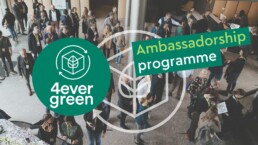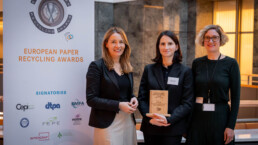In 2014, Ljubljana was the first capital city to commit to the Zero Waste Goal, followed by the honour of being appointed as the European Green Capital in 2016.
Time after time, Ljubljana has shown an innovative attitude and a firm commitment to sustainable standards. Their approach is holistic – in parallel to that of our own alliance, which brings together cross-industry representatives from the whole value chain. In their case, it rather means conceiving elements such as smart transport, green spaces, water treatment and waste management as part of a bigger scheme where environmental sustainability and citizen well-being must go hand in hand.
Mayor Zoran Janković tells us more about that vision.
Mayor Janković, Ljubljana has the reputation of being one of the most sustainable cities in Europe. What have been the key milestones in this journey?
In 2007, we set out on the path of sustainable development of the city with the Vision Ljubljana 2025 to ensure a high-quality life for all our citizens in a green, safe, clean, solidary, tolerant and comradely city. This was adopted at the beginning of my first mandate, and we are still pursuing these goals. In the Vision, we also identified 93 concrete development projects that have now been carried out or are in various stages of implementation. In addition to the above, we have initiated over 2,400 other projects for an even higher quality of life in the city, and we are currently preparing a new Vision Ljubljana to 2045.
Since 2007, over 17 ha of areas in the city centre have been renovated, transforming them from vehicle traffic areas into public areas reserved for walking, cycling and socialising. During this time, all parking lots in city centre squares were demolished, and the streets and embankments were renovated and planted with foliage and flora to create scenic public areas. For this initiative we received the European Award for Urban Public Spaces.
Today, Ljubljana can boast one of the largest pedestrian zones in an European city. Cyclists can ride over 310 km of maintained cycling paths with the BicikeLJ bicycle sharing system already establishing 83 stations with 830 bikes. We are also striving to increase r passenger- and environment-friendly public transport. Already 50% of the city passenger transport fleet consists of natural gas or hybrid powered buses, in addition, we offer free transportation on seven Kavalir electric vehicles in addition to the Urban electric tourist train. We are encouraging the further development of electromobility with various measures which includes among other things, a number of electric car and electric bicycle sharing systems available in Ljubljana. Indeed, Ljubljana was chosen as the best e-mobility city in Slovenia and the second most car-sharing friendly city in the world – in the category of up to 750,000 inhabitants.
The largest cohesion project, Clean for You, is extremely important for a healthy environment. As part of this project we are building a C0 connecting channel in the municipalities of Ljubljana, Medvode and Vodice. Here we are upgrading the water treatment plant and the sewage infrastructure, which will raise the coverage of the sewage system to as much as 98% (before 2007 this percentage was 68). With its construction, we will shut down as many as 6,400 septic tanks, from which wastewater freely flows into the environment and the groundwater.
Forests play a key role in a sustainable bioeconomy; for the fibre-based packaging industry, for example, they are the source of raw materials and the true beginning of the loop. Trees are also an indispensable part of your city, which has been recognised as a “Tree City”. Can you tell us more about this and other titles earned by Ljubljana?
Even though Ljubljana is one of the greenest capitals in the world (green areas cover as much as three-quarters of the city), we continue to plant new green areas in the city. We are turning brownfield sites, neglected and unused parts of the city into new green areas, thereby contributing to mitigating climate change and improving the quality of leisure time for residents and visitors to Ljubljana. In the past 15 years, we have planted more than 40,000 new trees and created over 120 ha of new green park areas, mostly on former brownfield sites. We are proud that Ljubljana is also recognised as a Tree City within the framework of the Tree Cities of the World programme. The award is presented by the Arbor Day Foundation and the Food and Agriculture Organisation of the United Nations (FAO).
As a result of the many changes towards better quality of life that we have implemented so far in our capital we have received many international awards. A real turning point and a great recognition for our work in this area was the honour of being named Europe Green Capital 2016. What is more, last year, the organisation European Best Destination declared us the best green capital among twenty European cities, and at the beginning of this year, Ljubljana was voted the European Best Destination 2022 – decided by travellers from all over the world. We received a record 92% of votes, from which many came from other countries prooving the immense international appeal of Ljubljana.
Ljubljana has implemented door-to-door collection system for biodegradable waste, together with the Pay As You Throw (PAYT). Can you tell us more about this? What has been the process of informing the citizens of Ljubljana and getting them on board?
I am proud that we have actually exceeded certain goals, such as reducing the amount of disposed mixed municipal waste by 30 kilograms per year. We are also making great progress with other goals, which, of course, would not be possible without the cooperation of our citizens. For example, in 2021, over 70 percent of municipal waste was collected separately, which is undoubtedly an effect of the PAYT system. After its adoption, citizens who collect a greater proportion of waste separately are rewarded with a lower cost of waste removal, which definitely serves as motivation.
Good results can only be achieved if the citizens are aware of the importance of sharing responsibility for the care of our environment. I am convinced that all the projects we have carried out to increase the quality of life in the city have also motivated citizens to care even more for the most beautiful city in the world. We continuously encourage our citizens to do so with various awareness-raising campaigns. For example, in 2015, when the proportion of separately collected waste increased significantly, instead of charging for this service in December, we sent people a greeting card invoice in the amount of 0 euros and a thank you note for their support
Finally, as Mayor of the capital of an EU Member State, how do you see Ljubljana’s plans and ambitions contributing to the targets of the EU Green Deal?
I am glad that the Green Deal was reached. I am firmly convinced that this is the path that all European cities and countries must follow if we want to give our grandchildren a future in a clean and healthy environment. In Ljubljana, we bravely face these challenges. In addition to the construction of the gas-steam unit, which is almost completed and will enable a 70% reduction in coal consumption at the very start of its operation, we have other key development projects. These include the increase in the use of renewable energy sources (wood biomass and the sun) and the construction of a facility for the energy use of non-recyclable mixed municipal waste.
The energy utilisation project of the Ljubljanica River, with the construction of three small hydroelectric power plants and a circular waterway is also aimed at the sustainable transformation of existing production resources. For greater energy efficiency, we are also successfully carrying out energy renovations of municipal buildings, saving over 180,000 trees. So far, we have already refurbished 86 buildings. A project for installing at least 3 MW solar power plants on public buildings ownenede City of Ljubljana is also being prepared. An analysis of possible procedures and financing, the suitability of buildings, a feasibility study and economic analysis iscurrently underway.
The new energy plan for Ljubljana envisages 40 percent gas, 20 percent biomass, 20 percent solar energy and hydropower on the Ljubljanica River, and 20 percent energy from an incinerator, eliminating the need for coal. We hope to be fully energy self-sufficient in four and a half years. For the incinerator we will choose only the best technology that will meet the highest standards both for the environment and health while making sure that the costwill be affordable for our citizens.
We are also applying to join the 100 carbon-neutral European cities by 2030 mission, whilst pursuing our own fundamental mission – to increase the quality of life for citizens and visitors to the city.
Undoubtedly, Ljubljana is one of the leaders in advancing the circular economy in Europe. However, such pride would not have been possible without strong determination and a clear desire for inclusion, aiming to make the Slovenian capital a welcoming space for visitors and an enjoyable place for citizens to live in.
We are eager to know where Vision Ljubljana 2045 will take them and what the process to ensure carbon neutrality will look like, wishing them the best of success to achieve new and promising milestones.
A year of collaboration and growth: discover 4evergreen’s 2023 Annual Report!
We are excited to launch 4evergreen’s 2023 Annual Report, looking back at our growth and achievements from the past year and recognising…
4evergreen launches new Ambassadorship programme
4evergreen is hitting the conference floors! This year, the alliance has launched a new Ambassadorship programme that will take us to major…
4evergreen wins European Paper Recycling Award
Brussels, 20 February 2024: The 4evergreen alliance has won a prestigious award from the European Paper Recycling Council (EPRC) in the…



